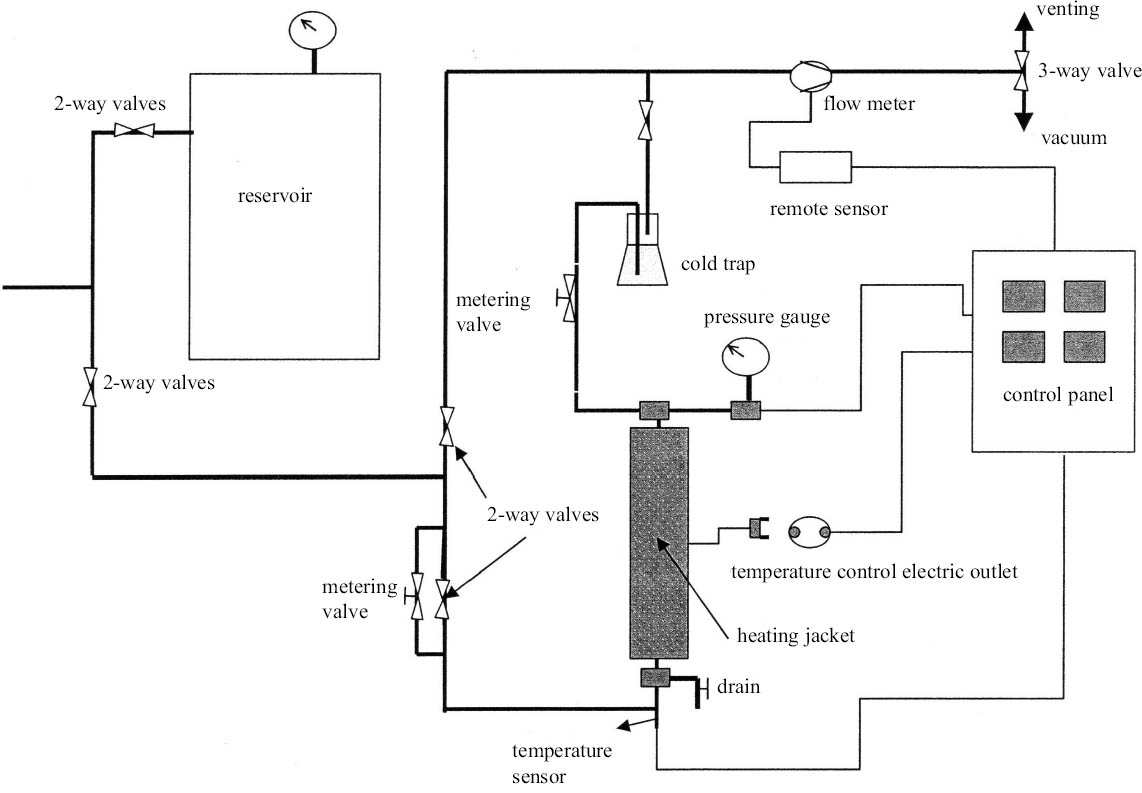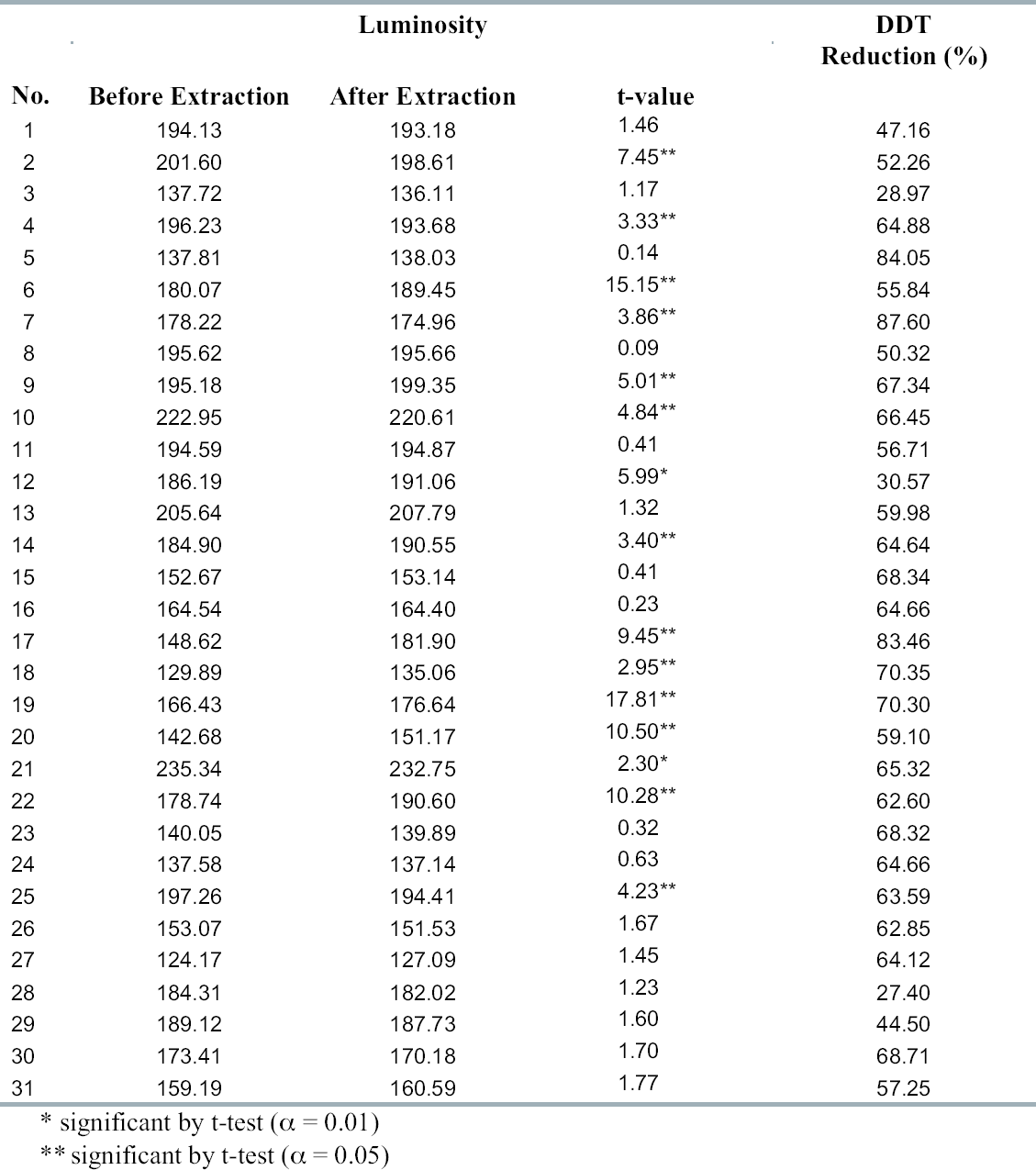THE EFFECT OF SUPERCRITICAL CARBON DIOXIDE EXTRACTION ON COLOR RETENTION AND PESTICIDE REDUCTION OF WOODEN ARTIFACTSSUNG MO KANG, ACHIM UNGER, & J.J. MORRELL
3 RESULTS AND DISCUSSIONScanning data were expressed on the basis of luminosity and red, green, or blue intensity. All four measurements appeared to be affected by extraction, but luminosity appeared to be the most consistently affected. Luminosity significantly changed in 15 of 31 treatments, with 6 treatments darkening, 9 treatments lightening, and the remainder unchanged (table 2). In most cases, the degree of color change, while significant, was difficult to detect with the naked eye. The relatively small changes in luminosity following extraction suggest that color changes might be further minimized using slight process variations to alter the solubility of specific pigment components. The presence of specific components in the coatings might be expected to render a material more or less susceptible to SCF extraction. SC carbon dioxide tends to work best with nonpolar materials because its polarity is lower than any hydrocarbon except All treatments with Naples yellow (nos. 4, 10, and 25) became darker after SCF extraction, suggesting this pigment might react with SC carbon dioxide during the process. A total of 20 coatings had a shellac component, and 9 of these turned significantly lighter with treatment. Shellac is an organic compound and should be very susceptible to SC carbon dioxide. Two other shellac-containing coatings experienced significant darkening, while the remaining 9 coatings were unaffected. Similarly, 14 coatings contained bone glue as their base, but only 4 of these experienced significant changes in luminosity. The presence of a specific component did not appear to consistently influence changes in luminosity. The results suggest that minor changes in coating can affect susceptibility to SC carbon dioxide, and careful testing of a coating will be essential prior to SCF extraction to ensure that it is not negatively affected by treatment. SCF easily extracted DDT from all specimens regardless of coating combinations, producing an average extraction efficacy of 60%. DDT levels declined by at least 50% of the initial retention in 26 of 31 coating treatments and about 45% in 2 others. DDT reductions were about 30% for 3 coating combinations (see table 2). SCF extraction solubilized substantial quantities of the chemical from within the sample. Longer extraction times would be expected to produce higher DDT reductions, as could higher pressures or the addition of co-solvents. One of the advantages of SCF extraction is the infinite adjustability of temperature and pressure conditions
Coating type did not appear to affect extraction efficiency, although some blocks were less thoroughly extracted. The reason for a lower degree of extraction with some coating combinations is difficult to determine. For example, three coatings contained bone glue followed by skin glue, stone chalk, champagne chalk, Bologna chalk, and shellac, followed by a final layer that varied by treatment. While the colors of all three samples did not differ significantly after SCF extraction, DDT reductions were 27.4%, 44.5%, and 68.71% of the initial DDT retentions, respectively.
Limewood and pine sapwood receiving the same coatings plus DDT were used to determine the effect of wood species on extraction. Each sample receiving the identical coating (two coats of linseed oil varnish) experienced similar % DDT reductions (see tables 1 and 2). Limewood and pine sapwood are both very permeable species, with permeabilities of 104 and 103cm3 (air)/(cm atm second), respectively (Siau 1971). Permeability can influence the penetration of super-critical fluid into wood. Schneider (1999) measured time-to-pressure equilibrium in 30 � 30 � 60 mm samples after vessel pressure reached 10.3 Mpa for pine sapwood, Douglas fir heartwood, spruce heart-wood, and red cedar heartwood. While the pressure equilibrated immediately in permeable species like pine, significantly extended time periods were required for the pressure equilibrium in Douglas fir, red cedar, and spruce heartwood. While SCF extraction was able to remove DDT from permeable species such as pine or limewood with minimum color alteration, further studies will be required to investigate extraction of impermeable species. Although SCF extraction successfully removed DDT from coated wood artifacts, our results clearly indicate that the extraction will require more systematic studies to understand how various coatings affect extraction efficiency and to minimize color change during the extraction. One advantage of SCF extraction is the ability to infinitely vary pressure or temperature and to employ modifiers to enhance the solubility of specific components or reduce that of others. The use of longer treatment cycles, alternative pressure and/or temperature conditions, and the addition of co-solvents would need to be explored to improve extraction efficiency without adversely affecting coating condition. |

